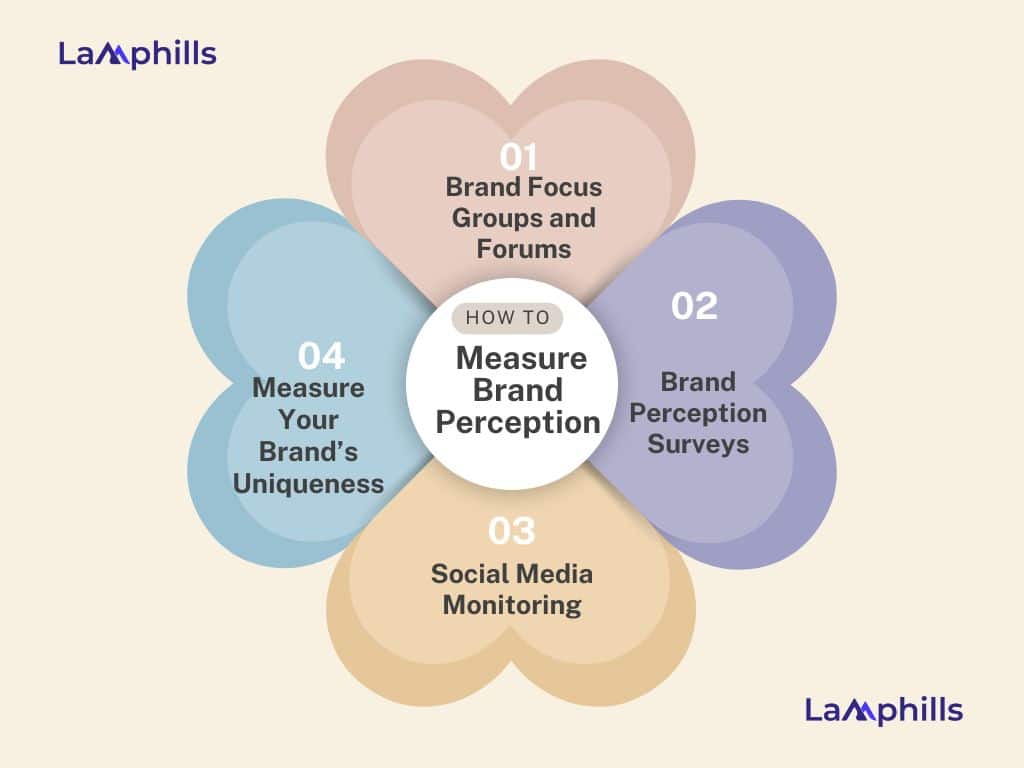Brand perception is how people see and feel about your company based on their interactions with your products, services, and marketing. It’s not just about what you say your brand is but how customers experience it. I once worked with a small business that was shocked to learn its customers saw it as outdated despite its modern branding efforts. It drove home that brand perception is shaped by more than a logo or slogan. This article will explore brand perception, provide real-life examples, and show you how to measure it effectively. Understanding how your brand is viewed is critical to building lasting customer trust and loyalty. Let’s get started!
Key Points
- Brand perception is determined by how customers experience your product or service, not just what your company says.
- Strong brand perception builds brand equity, which increases customer trust and loyalty.
- A brand map is a valuable tool for visualizing how customers perceive your brand compared to competitors. It helps identify gaps, strengths, and opportunities in the marketplace.
- Companies like Zoom and Chipotle have successfully reshaped their brand perception by responding to customer needs, repositioning themselves, and delivering targeted marketing campaigns.
- YBrand perception can be tracked through focus groups, surveys, and social media monitoring. Regularly analyzing this data allows businesses to adapt and maintain a strong, positive brand image.
What Is Brand Perception?

Credit: Freepik
Brand perception is what customers think about a product or service and how it makes them feel. It’s not about what the company claims. This perception is shaped by how customers use the product, their experience with it, how well it works, the brand’s reputation, and recommendations from others, both online and in person.
Every time a customer buys a product, reads a review, talks about it with friends, or interacts with your employees, they form an opinion about your brand.
While you can’t control every opinion, you can shape your brand’s message by creating a brand personality that reflects your company’s vision, mission, or culture and connects with customers.
To make a strong, lasting impression, try linking your brand to your customers’ five senses. This creates a deeper emotional connection. Here are some ways to engage the senses:
- Sight: Use memorable logos (like Coca-Cola, McDonald’s, or Disney) and engaging commercials.
- Sound: Include catchy jingles (like Intel) or popular phrases (like Kit Kat’s “Give Me a Break!”).
- Smell: Scents can evoke memories and emotions, like a café spreading the smell of bacon or airlines using unique fragrances in their cabins.
- Taste: Offer free samples or special promotions for new products.
- Emotion: Create ads that stir emotions, like the heartwarming Christmas commercials from John Lewis or Sainsbury’s.
You can use brand perception surveys to find out how customers, employees, and other stakeholders see your brand.
Why Is Brand Perception Important?
A strong brand perception is like a fast track to success. When customers trust your brand, they feel more confident buying your products. This trust also makes other businesses more willing to partner with you, and it simplifies launching new products.
The main goal of any brand perception effort is to build brand value and equity. Brand equity refers to the added value a company gains from having a recognizable name compared to a generic alternative. The higher your brand equity, the more likely customers are to choose your product over others, even when they have cheaper options.
In fact, customers often go for a product with higher brand equity, even if it’s priced higher than a generic version, simply because they feel more secure and comfortable choosing a brand they know and trust.
Read also: BRAND RESONANCE: Elevating Brand Resonance Through Experiential Engagement
Brand Perception Map

Credit: Freepik
A brand map is a visual tool that illustrates how customers or potential customers perceive a brand in comparison to its competitors. It helps businesses see where their brand stands in the marketplace based on certain characteristics or attributes.
These attributes can vary depending on the type of brand and the industry it operates in. Essentially, a brand map simplifies complex customer data by showing it in a two-dimensional format, even though it represents multiple layers of information, almost like compressing a 3D image onto a flat surface.
Brand mapping, also known as correspondence mapping, helps marketers and researchers understand the relative position of their brand in a competitive landscape. Sometimes, people also refer to these maps as perceptual maps, which visually display customer opinions and associations between brands and specific qualities, such as price, quality, or innovation.
For example, if you’re in the smartphone industry, a brand map might show how customers view Apple, Samsung, and Google phones in terms of innovation, reliability, and cost. This type of mapping helps you see gaps in the market or areas where your brand might have a competitive edge or where it needs improvement.
By using brand maps, businesses can more easily spot trends, strengths, weaknesses, and opportunities, allowing them to refine their strategies to better connect with their audience and outpace competitors.
Brand Perception Example
As times change and consumer needs evolve, companies often need to reposition themselves to influence how customers view their brand. Let’s dive into two real-world examples of how brand perception has been successfully reshaped.
#1. Zoom
While Zoom might seem like an overnight sensation, its journey began much earlier. Founded by Eric Yuan in 2011 and publicly launched in 2013, Zoom’s mission was simple: to make video communications easy and secure. However, it wasn’t until 2020 that Zoom really entered the mainstream, becoming a household name.
With its rapid rise, however, came some challenges. The term “Zoom fatigue” emerged as employees who spent long hours on the app reported exhaustion from the mental strain of video calls. By then, Zoom’s growth had started to plateau.
So, how did Zoom respond?
It repositioned itself to shift customer perceptions. The company launched its “How the World Connects” campaign and expanded its services beyond video with the introduction of the Zoom Phone. Zoom also emphasized its proven success, showcasing that 70% of the Fortune 100, over half of the Fortune 500, and 85% of the top cloud companies trust Zoom. Additionally, the brand highlighted how it supports secure communications for industries like healthcare, finance, and education.
This repositioning helped Zoom regain its momentum, reminding users of its wide-ranging impact and reinforcing its value beyond just video calls.
#2. Chipotle
Chipotle provides another great example of how smart marketing can shift brand perception. Traditionally, Chipotle has been seen as fast food, but the company wanted to change that, especially when promoting its “Lifestyle Bowls” designed for vegan, vegetarian, and keto customers.
To achieve this, Chipotle needed to be seen as a healthier, fresh option. Partnering with a marketing agency, they emphasized their use of natural, fresh ingredients in their made-to-order meals. The agency divided potential customers into distinct groups, like “Fitness Fanatics” and “US Health & Nutrition,” and targeted them with specific campaigns. They also used geo-targeting to attract new customers to local restaurants.
The results were outstanding: 10.7 million impressions and potentially 2.5 million new customers, with click-through rates exceeding benchmarks at 1.24%.
This case shows how important it is to tailor your message to the right audience, use in-depth audience analysis, and create highly targeted campaigns. By doing so, Chipotle successfully shifted its brand perception from just fast food to a fresh, healthy alternative.
These examples illustrate how thoughtful marketing and a clear understanding of your audience can transform brand perception and drive success.
How to Measure Brand Perception
Regularly tracking your brand perception is key to understanding how customers see you, identifying what drives improvements, and making informed decisions. Here are some effective ways to measure how your brand is perceived:

#1. Brand Focus Groups and Forums
It might feel a bit old-school, but getting people together in focus groups, whether in person or online, is still a great way to hear honest feedback about your brand. Whether it’s praise or criticism, you get a front-row seat to how customers truly feel. This feedback gives you insight into what’s working and what needs fixing.
Online forums can be especially helpful in complex supply chains, like B2B2C, where manufacturers might struggle to reach their end users. These forums bridge that gap by connecting you directly with your audience, offering valuable insights to inform product development and brand strategy.
#2. Brand Perception Surveys
Surveys are a straightforward and reliable way to learn who your customers are and what they think of your brand. They’re easy to set up and allow customers, whether they’re satisfied or dissatisfied, to express their opinions through targeted questions or open-ended responses. Common metrics like Net Promoter Score (NPS) and Customer Satisfaction (CSAT) scores provide the data you need. Running these surveys quarterly is ideal, but they can also be aligned with ad campaigns to see how your marketing efforts are shaping your brand.
#3. Social Media Monitoring
Social media is where people are brutally honest, making it a goldmine for real-time brand feedback. Monitoring platforms like Facebook, Twitter, LinkedIn, and Instagram helps you track mentions and reactions to your brand. By analyzing social data, you can see which platforms are working best for your brand, the type of content that resonates, and even influencer reach. Plus, using social listening tools with a single dashboard makes it easy to track engagement and respond quickly to feedback.
#4. Measure Your Brand’s Uniqueness
Every brand wants to stand out, but how do you know what makes yours unique? This is where open-text feedback comes in handy. When customers are free to express how they feel in their own words, you can analyze those responses using the right software to spot recurring themes and identify strong associations. This helps you understand exactly what sets your brand apart in the minds of your customers.
By consistently using these methods, you can monitor how your brand is perceived and make the adjustments needed to stay ahead in the market.
Whether you’re a small business or an established brand, this Checklist for Improving Brand Perception will give you the insights and tools you need to build stronger emotional connections with your audience.
How to Act on Insights to Improve Brand Perception.
When you do the following, it will greatly impact the perception of your brand by the customers:
#1. Reevaluate Your Brand
If your brand perception research shows that your brand isn’t resonating with customers, it may be time for a refresh. Updating your brand can breathe new life into its image. Take Mastercard, for example. They modernized their 1960s logo by focusing on simplicity, connectivity, and a seamless design. The updated logo features a bright, glowing color palette that stands out against various backgrounds, giving it a fresh look.
#2. Get the Right Leadership Involved
Successful brand perception shifts require strong leadership. You’ll need a senior team that fully supports the vision and understands the importance of this change. Since this process can be resource-heavy, it’s essential that leaders are engaged and can track progress in real-time through data dashboards. Their commitment will help drive the change forward.
#3. Listen to Your Customers
You can’t dictate how customers perceive your brand; they need to tell you. Send out surveys to gather feedback and train your employees to have meaningful conversations with customers. Make sure they listen carefully to customer opinions and share that feedback with the team. Customer input is invaluable when shaping your brand’s perception.
#4. Engage Your Employees
Your employees are at the heart of your brand. They create, sell, and market your products and services. It is crucial to include them in your efforts to improve brand perception. Involve employees from all departments and encourage open, honest feedback. An anonymous online suggestion box is a great way to collect genuine input. You can use a template to get started.
#5. Let Your Content Do the Talking
Once you know who your target audience is, focus on delivering the right content to them. Make sure your website, blog, and social media channels clearly communicate your brand messaging and are optimized to reach a wide audience. Consistent, relevant content will reinforce the perception you want to build.
#6. Stay Open to New Opportunities
The business landscape is constantly evolving, and your brand needs to be ready to adapt. Be open to diversifying beyond your traditional core offerings. Emerging opportunities can sometimes lead your brand in new directions you didn’t originally anticipate, so always be on the lookout for ways to grow and evolve.
Related Post
PR BUSINESS: Shaping Perceptions and Building Brands Through Public Relations (The People’s Voice)
Reputation Marketing: Building and Sustaining a Positive Brand Image
16 Compelling Brand Video Examples and 10 Tips for Creating One
CSR Companies to Watch: How Top Brands Are Shaping Social Impact






